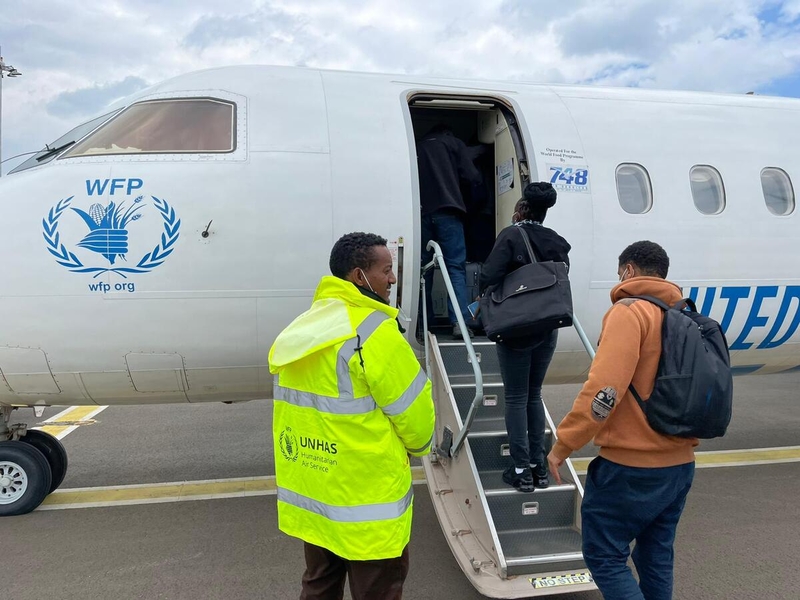WFP Sends First Humanitarian Passenger Flight Into Tigray

ADDIS ABABA – The first United Nations Humanitarian Air Service (UNHAS) passenger flight, which is managed by the United Nations World Food Programme (WFP), has touched down at Tigray’s Alula Aba Nega International Airport in Mekelle today.
It is the first passenger flight into the region since commercial flights were halted on June 24 and carried more than 30 employees from multiple humanitarian organizations working to deliver urgently needed assistance to conflict-affected communities across Tigray.
“The U.N. World Food Programme and our fellow emergency responders on the ground in Mekelle are all enormously relieved to see this UNHAS flight arrive today, bringing in colleagues who are all essential in our collective efforts to scale up the humanitarian response and for the U.N. World Food Programme to reach 2.1 million people with lifesaving food assistance,” said Michael Dunford, the U.N. World Food Programme’s Regional Director for Eastern Africa.
From today, the UNHAS flights will operate twice a week, facilitating the regular movement of humanitarian personnel into and out of Tigray. However, the humanitarian response in the region continues to be challenged by a lack of sufficient food and other humanitarian supplies, limited communication services and no commercial supply chain.
With conflict escalating in surrounding regions, including Afar, the safe and secure passage for convoys to move humanitarian supplies into Tigray remains a primary concern for the U.N. World Food Programme and the humanitarian community, particularly after a U.N. World Food Programme convoy was attacked on the morning of July 18 while attempting to move essential humanitarian cargo into Tigray.
Another U.N. World Food Programme-led convoy of over 200 trucks containing food and other essential humanitarian supplies is currently on standby in Semera and expected to depart for Tigray as soon as security clearances are assured.
“Famine is preventable and the power to avert it is in the hands of all parties concerned. The U.N. World Food Programme is calling for all parties to agree to a ceasefire so the humanitarian response can be rapidly scaled up and all routes can be used urgently to reach those most in need,” added Dunford.
- Despite the numerous challenges, the U.N. World Food Programme has managed to deliver food to over 730,000 people in parts of the south and northwest in the past month (under Round 2 distributions). This includes 40,000 people in Zana who were reached with food assistance for the first time.
- The U.N. World Food Programme hopes to reach an additional 80,000 people in the northwest in the coming days. Once this is completed, food stocks are likely to run out.
- The U.N. World Food Programme and its nutrition partners are working together to ensure nutrition supplies are reaching the families most in need. In June, the U.N. World Food Programme reached over 185,000 people with nutrition support but progress in early July was much slower due to security concerns with 30,000 people reached so far. The U.N. World Food Programme is now delivering nutrition support in areas previously unreached throughout the conflict, including those with high malnutrition rates.
- There is currently 7,500 metric tons of food inside Tigray stored in the U.N. World Food Programme’s warehouses in Mekelle and Shire. The U.N. World Food Programme recently added an additional 13 trucks to its fleet within the region and plans to move in 30 more as soon as it is guaranteed safe and secure passage to do so.
- The U.N. World Food Programme is providing logistics capacity to the Joint Emergency Response (JEOP, a consortium of NGOs funded by the United States) by transporting urgently needed food to those communities which haven’t yet been reached, particularly in rural areas in central zone.
- The Integrated Food Security Phase Classification analysis in June projected that over 400,000 people would be suffering from catastrophic levels of hunger from July onwards. Across Tigray, 4 million people—70 percent of the population— have high levels of acute food insecurity and need emergency assistance.
- Across Ethiopia, the U.N. World Food Programme aims to reach 11.9 million people in 2021 with food, nutrition and cash support and delivering activities to boost communities’ self-reliance and capacity in order to be food secure.
- The U.N. World Food Programme needs $176 million to continue to scale up its response in Tigray to save lives and livelihoods to the end of the year. For all activities under its Country Strategic Plan, the U.N. World Food Programme has a funding shortfall of $377 million. Additional funding is vital to allow the U.N. World Food Programme to keep saving and changing lives in Ethiopia.
# # #
The United Nations World Food Programme is the 2020 Nobel Peace Prize Laureate. We are the world’s largest humanitarian organization, saving lives in emergencies and using food assistance to build a pathway to peace, stability and prosperity for people recovering from conflict, disasters and the impact of climate change.
Follow us on Twitter @WFPUSA, @wfp_media and @wfp_ethiopia




